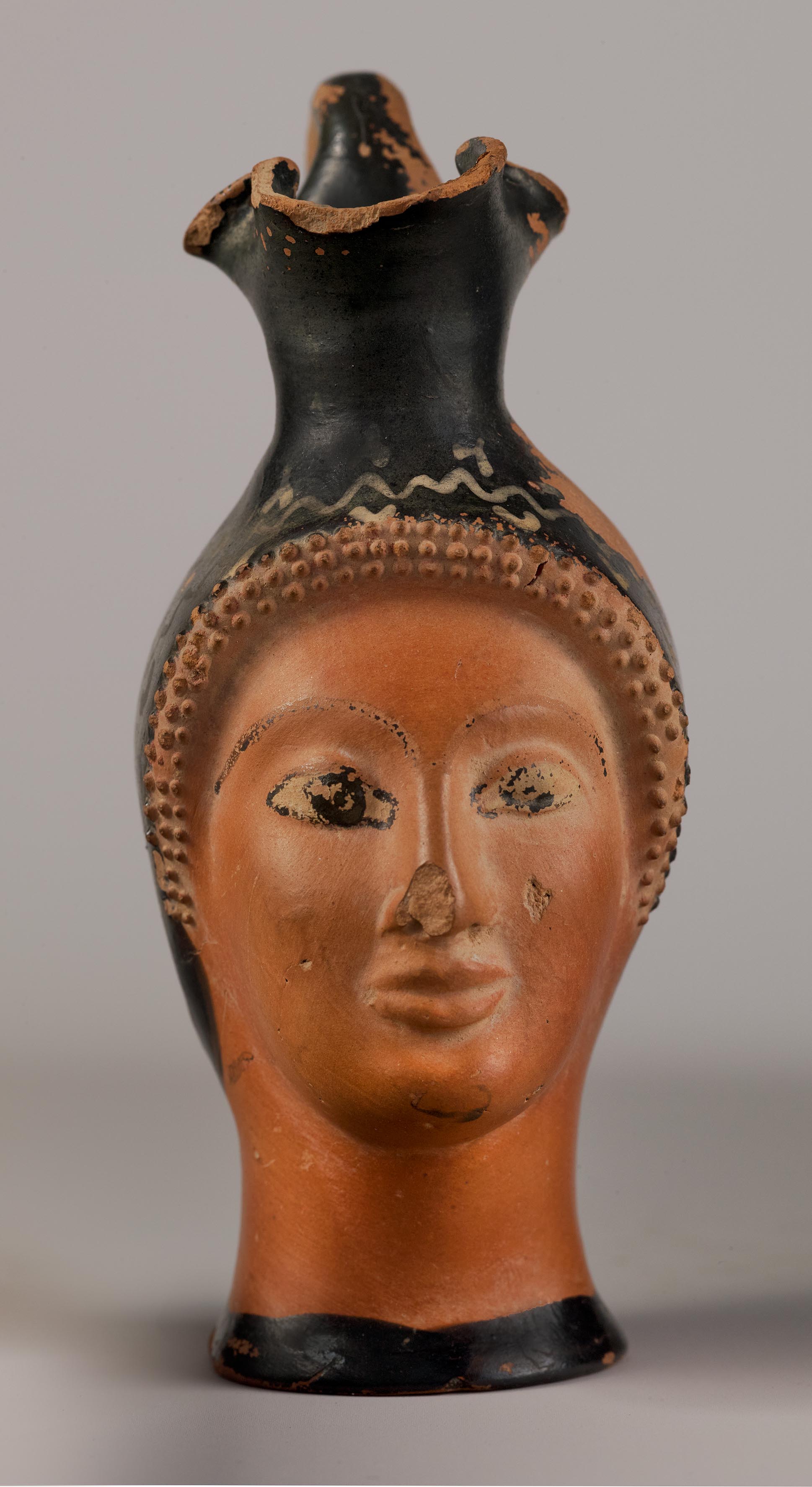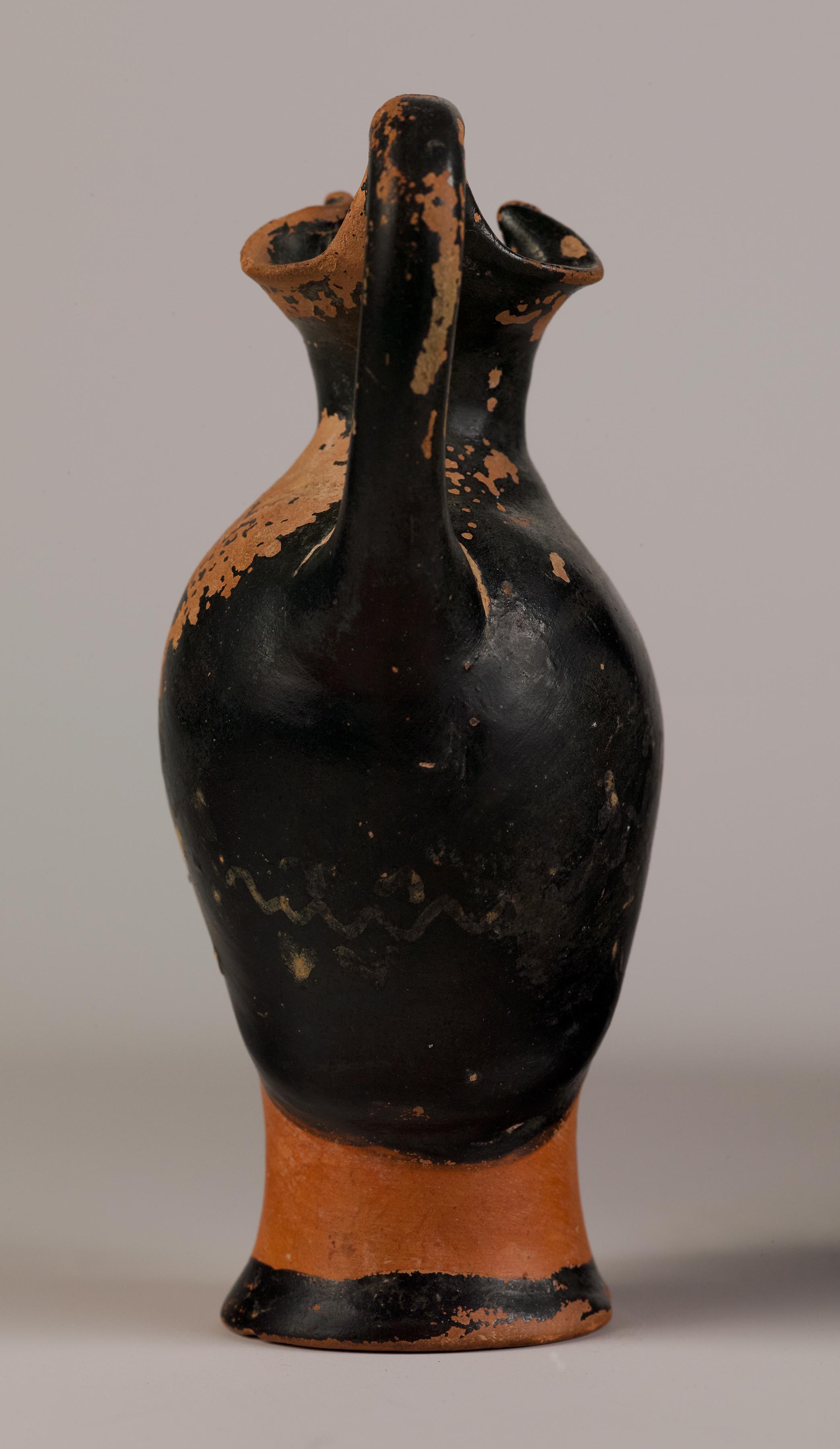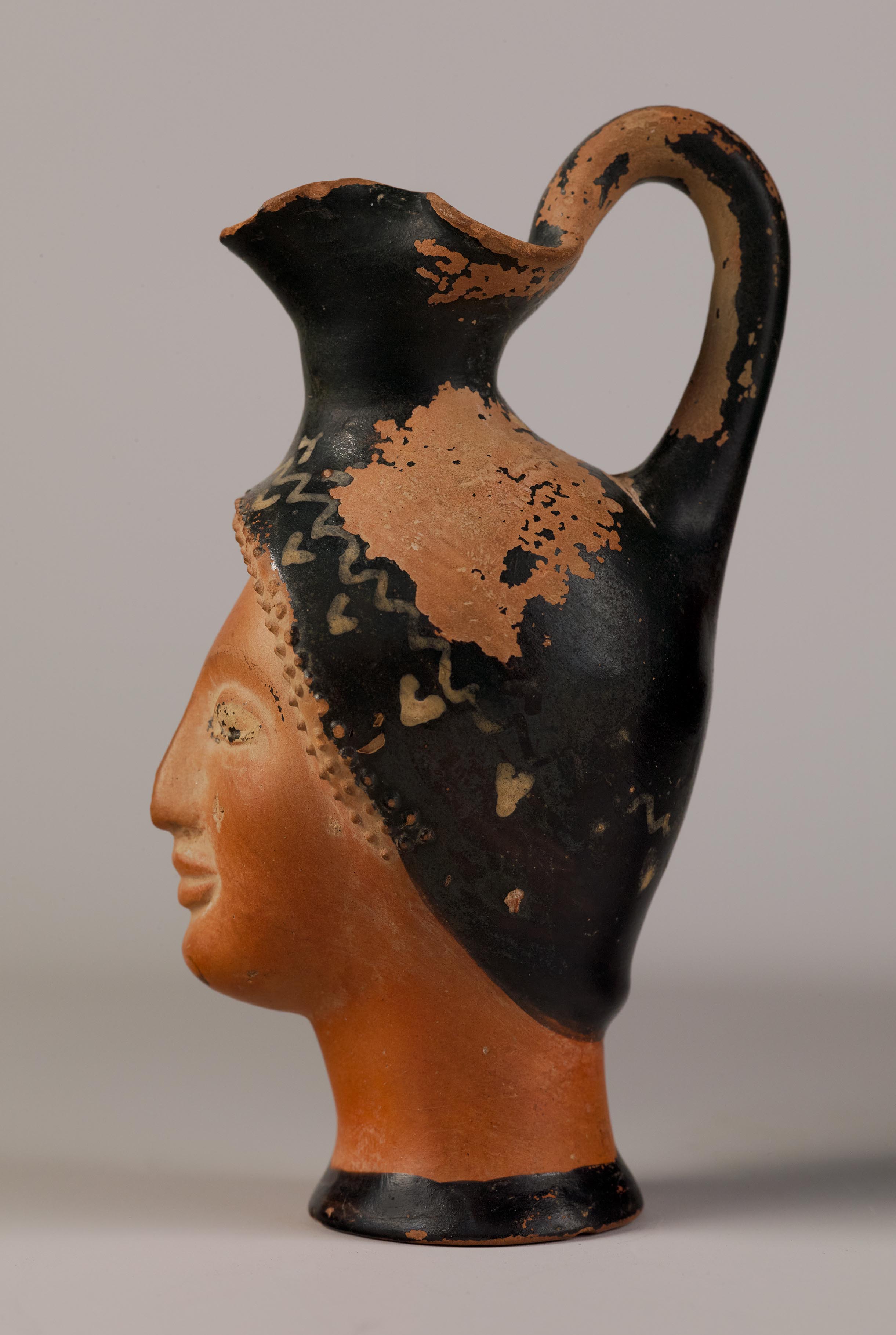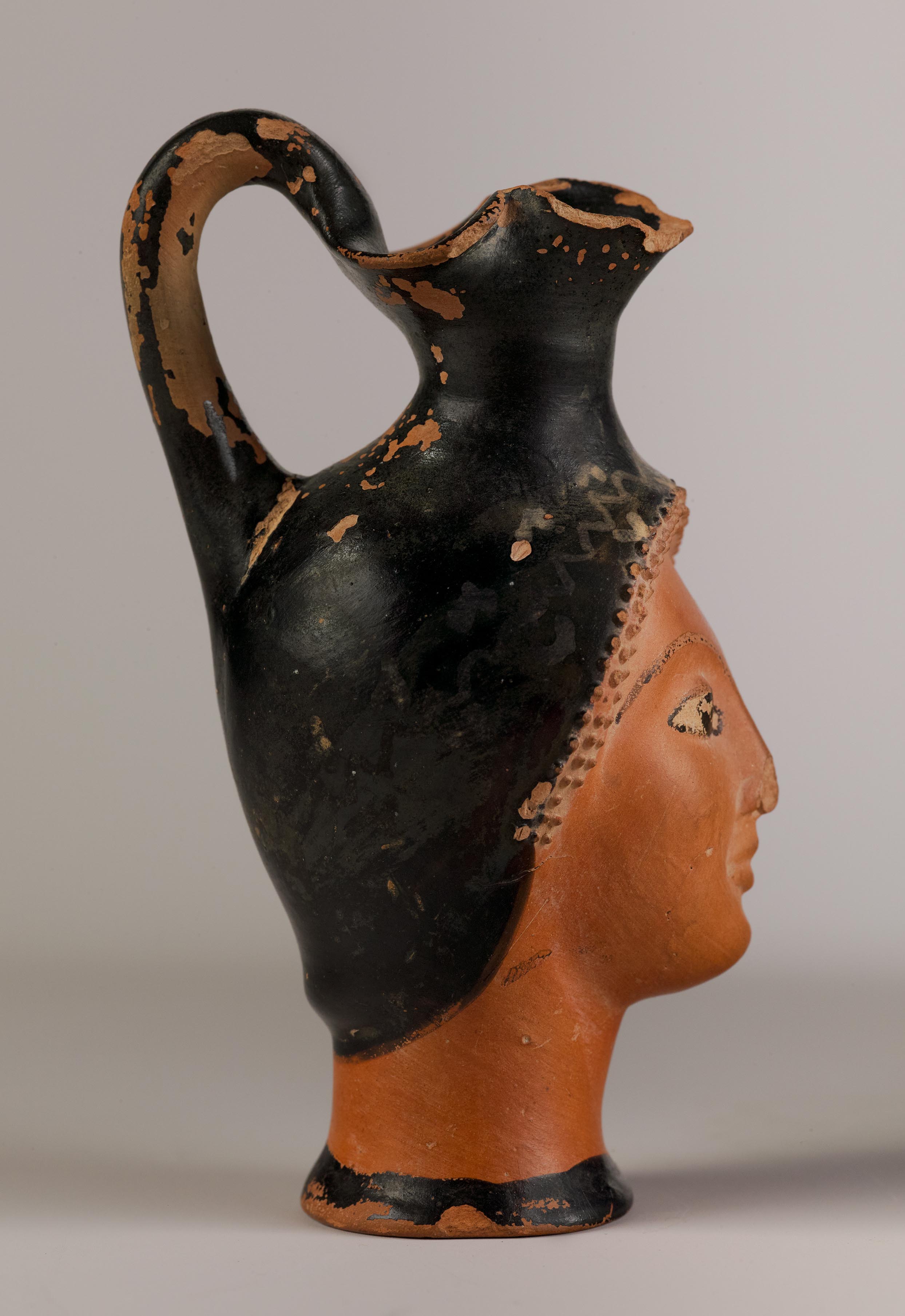Provenance
Before 1959, Vladimir G. Simkhovitch; 1959–2004, Helena Simkhovitch Didisheim and Paul Didisheim; 2004, gift, Helena Simkhovitch Didisheim and Paul Didisheim to Princeton University.
Shape and Ornament
Trefoil mouth with black interior and slightly flaring lip. Vertical handle, black and round in section, rising slightly above the rim. Molded body in the form of a female head. Hair black, except at front, where three rows of tiny, unpainted clay pellets curve over the top of her face. Above these is a white ivy wreath with zigzag stem. A slight swelling above the nape may suggest that the figure wears a sakkos, but this is far from clear, and sakkoi are almost never black. Ears are not represented. Oval face with rounded chin, narrow jaw, straight nose, and full lips. Eyes outlined in black, with white irises and dotted black pupils; high arching black eyebrows. Flaring, wheel-made neck forming flat base. Thin black stripe at the bottom of the neck, perhaps the beginning of a garment.
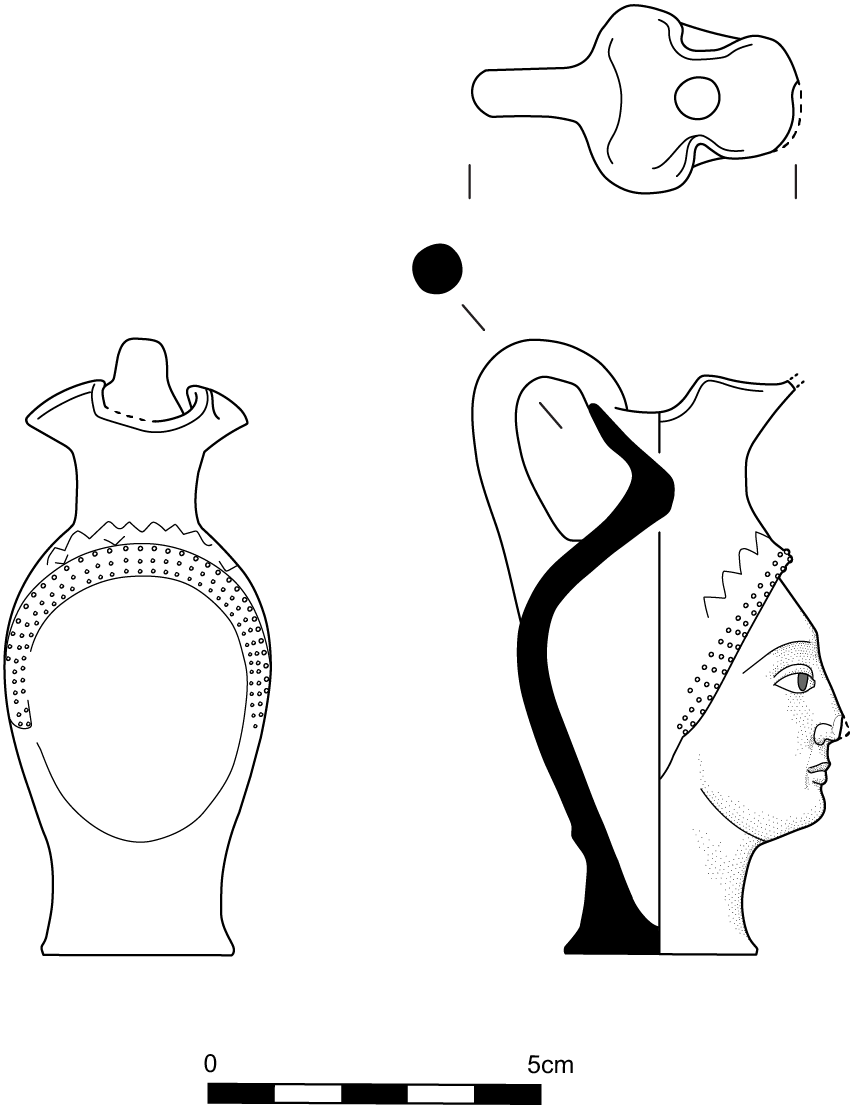
Attribution and Date
Attributed to the Cook Class [W. Rudolph and A. Calinescu]. 480–470 BCE.
Dimensions and Condition
h. (with handle) 9.4 cm; h. (without handle) 9.0 cm; diam. 3.9 cm; diam. of mouth (lateral) 2.8 cm; diam. of mouth (back to front) 3.2 cm; diam. of base 3.1 cm. Unbroken. Tip of the nose lost, and three pellets of the hair. Most of the gloss for eyebrows and eyes heavily worn, in particular on the left eye. Front lobe of mouth of the vase chipped, as well as the left cheek and base. Black gloss flaked on the handle and left side of the head.
Technical Features
The body is mold made. Curls of hair rendered with raised clay pellets. Accessory color. White: ivy wreath. Traces of red on hair and lips.
Bibliography
W. Rudolph and A. Calinescu, eds., Ancient Art from the V. G. Simkhovitch Collection, exh. cat., Indiana University Art Museum (Bloomington, IN, 1988), 143–44, no. 136B.
Comparanda
For the Cook Class, see Abbreviation: ARV2J. D. Beazley. Attic Red-Figure Vase-Painters. 2nd ed. Oxford, 1963 1539–44, 1698; Abbreviation: ParalipomenaJ. D. Beazley. Paralipomena: Additions to Attic Black-Figure Vase-Painters and to Attic Red-Figure Vase-Painters. Oxford, 1971 503–4; Abbreviation: BAdd2Carpenter, T. H., ed. 1989. Beazley Addenda: Additional References to ABV, ARV2, and Paralipomena. 2nd ed. Oxford: Published for the British Academy by Oxford University Press. 387; J. D. Beazley, “Charinos: Attic Vases in the Form of Human Heads,” Abbreviation: JHSJournal of Hellenic Studies 49 (1929): 61–65, 78; W. Hornbostel, ed., Aus Gräbern und Heiligtümern: Die Antikensammlung Walter Kropatscheck (Mainz, 1980), 122; M. de Cesare, in CVA Vibo Valentia 1 (Italy 67), 41; N. Kunisch, in CVA Bochum 2 (Germany 81), 30–31; E. Trinkl, in CVA Vienna 5 (Austria 5), 41. On the dating of the Cook Class head-vases, see P. Mingazzini, Catalogo dei vasi della Collezione Augusto Castellani II (Rome, 1971), 32. For head-vases in general, see M. Trumpf-Lyritzaki, Griechische Figurenvasen des reichen Stils und der späten Klassik (Bonn, 1969); F. Croissant, “Collection Paul Canellopoulos (IV): Vases plastiques attiques en forme de têtes humaines,” Abbreviation: BCHBulletin de correspondance hellénique 97 (1973): 205–25; W. R. Biers, “Some Thoughts on the Origins of the Attic Head Vase,” in Ancient Greek Art and Iconography, ed. W. G. Moon (Madison, WI, 1983), 119–26; F. Lissarrague, “Identity and Otherness: The Case of Attic Head Vases and Plastic Vases,” Source: Notes in the History of Art 15 (1995): 4–9. The Cook Class (Group N), one of over twenty classes of Attic head-vases identified by Beazley, is by far the largest, mostly consisting of oinochoai of shape 1 with a woman’s head. The Class is distinguished, in part, by the applied clay pellets for the curls on the forehead of the woman. For the technique of added clay pellets, see B. Cohen, “Bubbles=Baubles, Bangles and Beads: Added Clay in Athenian Vase Painting and Its Significance,” in Greek Vases: Images, Contexts and Controversies; Proceedings of the Conference Sponsored by The Center for the Ancient Mediterranean at Columbia University, 23–24 March 2002, ed. C. Marconi (Leiden, 2004), 55–72; Abbreviation: Cohen, “Added Clay and Gilding”B. Cohen. “Added Clay and Gilding in Athenian Vase-Painting.” In The Colors of Clay: Special Techniques in Athenian Vases, pp. 106–17. Exh. cat. The J. Paul Getty Villa, Malibu, June–September 2006. Los Angeles, 2006, 106–17.
Otherwise, vessels of the Cook Class have many points in common with other small female head oinochoai, including those of Classes G, J, Q, and T: the lack of modeled ears, the ivy wreath in added white, and the black band at the bottom of the neck. The Cook Class began in the Late Archaic period and continued into the Early Classical period as sub-Archaic products, maintaining the Archaic stylized curls, arched eyebrows, and wide, almond-shaped eyes. The faint Archaic smile and the compact head place Princeton’s oinochoe in the Late Archaic phase: cf. the later Berlin F 2192 (Abbreviation: ARV2J. D. Beazley. Attic Red-Figure Vase-Painters. 2nd ed. Oxford, 1963 1540.40; Abbreviation: BAPDBeazley Archive Pottery Database. http://www.beazley.ox.ac.uk 218475), with little trace of a smile and a longer face and neck. For similar Late Archaic styling, cf. Erlangen I 390 (Abbreviation: ARV2J. D. Beazley. Attic Red-Figure Vase-Painters. 2nd ed. Oxford, 1963 1540.50; Abbreviation: BAPDBeazley Archive Pottery Database. http://www.beazley.ox.ac.uk 218485); Vienna 998 (Abbreviation: ARV2J. D. Beazley. Attic Red-Figure Vase-Painters. 2nd ed. Oxford, 1963 1541.57; Abbreviation: BAPDBeazley Archive Pottery Database. http://www.beazley.ox.ac.uk 218491), with a similar zigzag ivy wreath. The vessels in Erlangen and Vienna, however, are much larger, as are most oinochoai of the Cook Class. Rarely are such head-vases under 10 cm, with most in the range of 15 to 20 cm including the handle. The Princeton head has only three rows of clay, unlike the more common four rows. For another example of this size, which also has a relatively low handle and short neck, cf. Dresden ZV 1828 (CVA Dresden 2 [Germany 97], 74–75, pl. 59; Abbreviation: BAPDBeazley Archive Pottery Database. http://www.beazley.ox.ac.uk 9034413). There are other examples, all of which we may characterize as “miniatures,” perhaps indicating a function as a perfume or oil container: see Trumpf-Lyritzaki, Griechische Figurenvasen, 124.
The identity of the women in head-vases may be indicated by the type of wreath worn, with ivy wreaths characteristic of maenads and the vase form perhaps indicative of a cultic function as a libation vessel; see M. Blech, Studien zum Kranz bei den Griechen (Berlin, 1982), 185–209. N. Kunisch (CVA Bochum 2 [Germany 81], 30), however, claims that the ivy wreath indicates that the women are hetairai and that the oinochoe should rather be connected with the symposion. Lissarrague (“Identity and Otherness,” 4) suggests that the female head-vase assimilates the human function of subservient wine-pourers at libations and symposia. The role of the woman as a wine-pourer does not rule out her identification as a maenad, as maenads wearing ivy wreaths may pour libations to Dionysos. The female head is occasionally paired with the head of an African male on janiform vessels, leading some to claim that the man is the subject or enslaved by the woman: see M.-F. Baslez, L’étranger dans la Grèce antique (Paris, 1984), 197. For an overview of interpretations of the iconography and use of female head-vases, see Abbreviation: PandoraPandora: Women in Classical Greece. Exh. cat. Walters Art Gallery. Edited by E. D. Reeder. Baltimore, 1995, 212–15.
